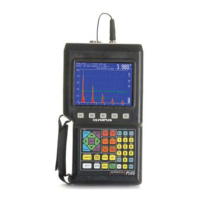Appendix C – Glossary
Part # 910-250C
169
Mode Conversion Changing a portion of a sound beam’s energy into a
wave of a different mode due to refraction at incident
angles other than zero degrees. In NDT, this usually
involves conversion of longitudinal waves into shear
waves or surface waves.
Peaking Up Maximizing the height of any indication displayed on
the CRT screen by positioning the main axis of the
sound beam directly over the reflector.
Penetration The ability of the test system to overcome material loss
attenuation, that is, the ability of the sound beam to by-
pass small reflectors such as grain boundaries and
porosity in the specimen.
Piezoelectric Elements A family of materials (such as lead metaniobate,
quartz, lithium sulfate) that possess the characteristic
ability to produce: a) A voltage differential across their
faces when deformed by an externally applied
mechanical force, and b) A change in their own
physical configuration (dimensions) when an external
voltage is applied to them.
Probe Another name for transducer or search unit
Pulse Repetition Rate or
Pulse Repetition Frequency
The frequency with which the clock circuit sends its
trigger pulses to the sweep generator and the
transmitter, usually quoted in terms of pulses per
second (pps).
Range The distance represented by the entire horizontal CRT
screen display.
Receiver That circuit of a flaw detector that receives both the
initial pulse voltage from the transmitter and the
returning echoes (as voltages) from the transducer. By
passing these incoming signals through certain
subcircuits, the signals are rectified, filtered and
amplified with the results send to the screen for display.
Reference Echo The echo from a reference reflector.
Reference Level The number of decibels of calibrated gain which must
be set on the instrument to bring the reference reflector
signal to peak at the reference line on the screen.
Reference Line A predetermined horizontal line (usually dictated by
specifications) on the screen representing some
percentage of total screen height, at which reference
echoes and indication echoes are compared.
Term Definition

